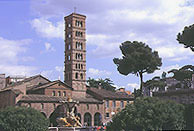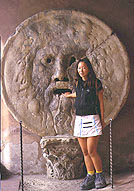Very Interesting Churches
St. Maria in Cosmedin
 One of churches: medieval and very austere.
One of churches: medieval and very austere.
Outside. The bell tower is a fine example of Medieval brick work: seven stories of windows with baby columns, and plates or porphyry discs stuck into the facade.
Inside. The sparse interior has not been changed in character since the 1100s. All the columns and capitals come from Roman times. In the Dark Ages, there was a gallery for women to worship upstairs out of the men's way.
The rood screens (between the altar and public area) and the glorious floor are particularly fine examples of the Cosmati technique of mosaic-like decorative patterns.
The altar is a porphyry bath from Roman times! Porphyry marble mines ran dry in 100 BC. Very appreciated for its dark purple salami color, all pieces made since then have been carved out of other sculpted pieces.
In the sacristy is an 8 C mosaic on gold ground, originally in the old St. Peter's.
Legend. Aeneas is supposed to have settled here once he arrived from Troy. 495 BC. On these marshlands stood a massive altar and Temple to Hercules. 69-81 AD. Under the Flavian Emperors a columned hall was built for inspectors of the grain, fruit and vegetable market (Forum Holitorium) just outside. They checked that customers did not get cheated. Nearby was the stable of thoroughhbreds for the chariot races in Circus Maximus. Also a Temple to Mithras where charioteers could pop in for a prayer before the race. 200 AD. A tiny chapel below ground thought to be part of the foundations of the temple (now the crypt), was built for worshippers who risked death to come here. 6C. A small church was erected for Rome's Greek population. 782. Pope Adrian I enlarged and beautified the building for the flood of Byzantine refugees from Constantinople escaping the Iconoclastic persecutions (when worship of images was forbidden). 1223. Restored again, and the floor redone, perhaps the first Cosmati floor.![]() Cosmati in Cosmedin. “In Cosmedin” means cosmetics, therefore beautiful, in Greek. In the 12C AD the then revolutionary use of broken Roman artifacts assembled into beautiful surfaces became the height of fashion. The Cosmati family (did their name come from the church?) were in a lucrative business for 200 years creating these fabulous floors.
Cosmati in Cosmedin. “In Cosmedin” means cosmetics, therefore beautiful, in Greek. In the 12C AD the then revolutionary use of broken Roman artifacts assembled into beautiful surfaces became the height of fashion. The Cosmati family (did their name come from the church?) were in a lucrative business for 200 years creating these fabulous floors.
St. Maria in Cosmedin
History
Mouth of Truth

(Bocca della Verità). Ancient Roman giant marble disc sculpted into a human face. This used to be a drain. (How nice to have functional drains be beautiful and funny).
Tradition has it that if you put your hand into the mouth and tell a lie, it will bite your hand off. We know that a priest used to hide behind the marble face and whack the wrists of known liars, making them yelp with pain.
A favorite place for mothers with unruly children, and wives with unfaithful husbands.
St. Pudenziana
(St. Pudenziana and St. Prassede were sisters). Set deep in the ground, this church, one of the oldest in Rome, has a long unbroken history of worship. The ancient building (rebuilt on 384 AD by Pope Siricius) is beautiful, and if you're lucky you might be able to see the Roman Baths (behind the “Custode's” door).
Now a Filipino enclave, if you visit during a fair, sample some of their delicious food.
Facade: fine medieval frieze in marble over the weathered original door.
Interior: 4C mosaics glitter, covering the wall behind the altar. Wallowing in water, on either side of Christ, are (right) a winged bull, and (left) a lion with wings - its face the exact copy of the Lion in "Wizard of Oz".
| St. Pudenziana History BC. A private house in Republican times. 60 AD. Senator Pudens, father of St. Pudenziana and St. Praxedes (Prassede), invited St. Peter to stay in his house, while the latter was awaiting trial in Rome. Peter baptized the two sisters, probably in the good Senator's private Baths. 2C. Later this became a small public bathing establishment. 4C. A church was built over the house, dedicated to one of the sisters. 8C. It was restored; and again in the 11C and 12C 17C. The nearby Filipino convent was built. |
Via Urbana, 160
St. Prassede
(Chiesa di Santa Prassede) (St. Pudenziana and St. Prassede were sisters)
Pope St. Paschal built (822 AD) this church to honor his mother Theodora; the chapel of St. Zeno, half way down the nave, is the best example of Byzantine art in Rome. Cosmatesque pavements pattern the floor, with a marble porphyry disk commemorating where St. Praxedes hid early Christian martyrs' bodies.
Although the re-shoring of an oft-sagging building has altered the original structure, the 9C mosaics are intact and in profusion, as are the two sisters depicted in them. If you see a woman with a square halo (called nimbus) it is of Theodora, showing she was still alive at the time.